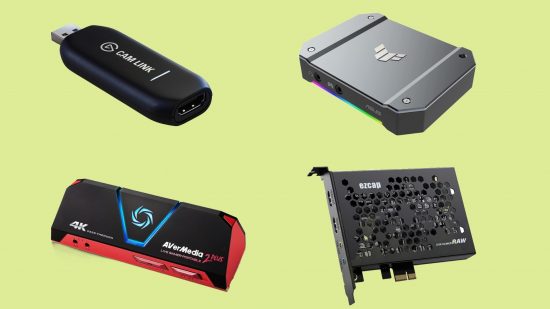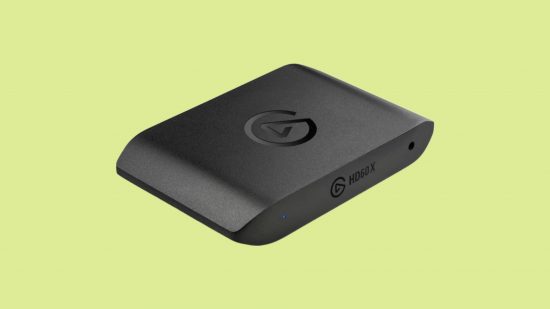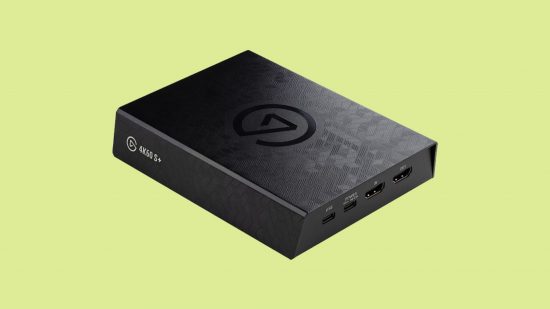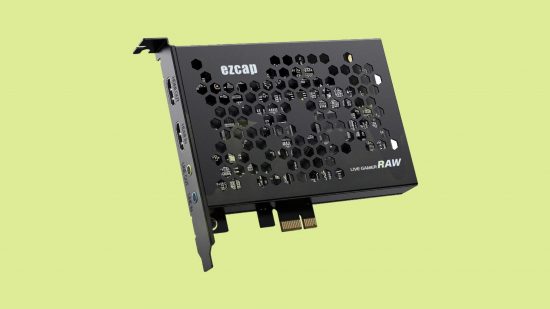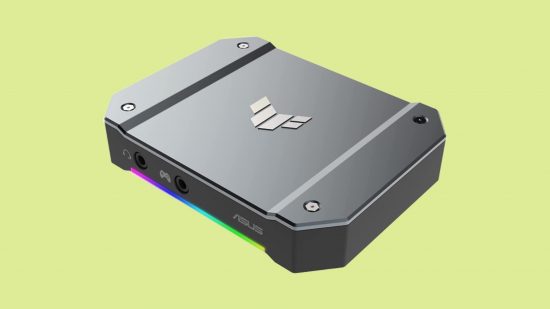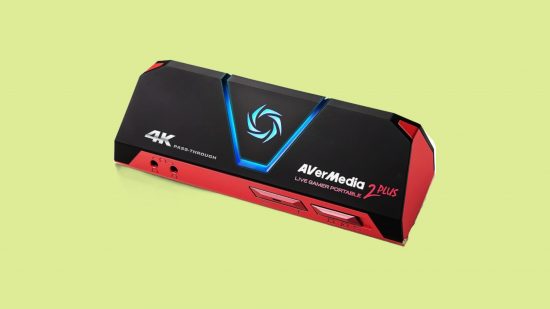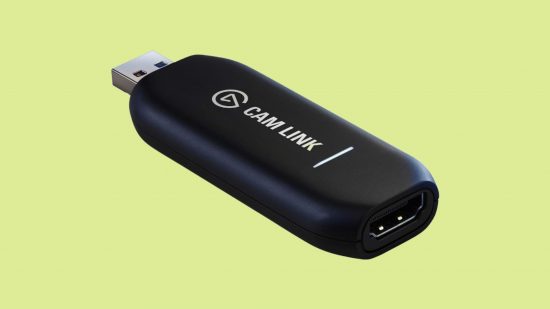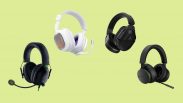The best capture cards let you record your screenplay and If this is something you’ve never done before, deciding which capture card to go for may be a bit of a daunting task. To save you from trawling through hundreds of products, we’ve picked out six top capture cards for gaming and streaming to get you started.
A good capture card is essential for stepping into the world of streaming, and you’ll probably want to make sure that you’ve got the best webcam, streaming lights, and the best streaming microphone to complete your setup. If you’re just starting out, read our guide on the best streaming setup for beginners.
These are the best capture cards today:
- Elgato HD60 X – best capture card overall
- Elgato 4K60 S+ – best for 4k footage
- MyPin Game Capture Card – budget choice
- Asus TUF CU4K30 – best USB-C capture card
- AverMedia Live Gamer Portable 2 Plus – best 1080p card
- Elgato Cam Link 4K – best for external cameras
1. Elgato HD60 X
The Elgato HD60 X is the best capture card overall.
Elgato HD60 X specs:
| Resolution | 1080p |
| Frame rate | 60fps |
| Works with | Xbox Series X|S, PS4, PS5, Nintendo Switch, PC |
| Inputs/outputs | HDMI |
Pros:
- Cool gameplay rewind feature
- Supports next-gen consoles
Cons:
- Can’t capture on Mac
- Struggles with 4k
Elgato has been a big name in the capture card world (and the gaming hardware world generally) for years. The HD60 X is a fantastic capture card designed to work well with both the PlayStation 5 and the Xbox Series X.
We should note that the quality of the footage that it captures isn’t quite 4k, but it’ll be close enough for some readers. For the price, you’re getting something pretty impressive, and the gameplay you capture will be at a smooth 1080p or 1440p resolution. It looks fantastic, really, it just might struggle if you want to really show off the finer details in the most powerful, cutting-edge PS5 and Xbox Series X exclusives.
It also features an impressive rewind feature, which means that you don’t even need to actually be recording in order to capture your most exciting moments. Just flick it on, and then you can rewind to the period of time when it was off. With that, you’ll be able to make sure all your best gaming moments are preserved for eternity. It’s an excellent bonus in an already great capture card.
2. Elgato 4K60 S+
The Elgato 4K60 S+ is the best 4k capture card.
Elgato 4K60 S+ specs:
| Resolution | 4K |
| Frame rate | 60fps |
| Works with | PS5, Xbox Series X, PS4, Xbox One, Nintendo Switch PC |
| Inputs/outputs | HDMI |
Pros:
- Captures 4k footage
- Easy recording
Cons:
- Won’t work with HD Capture Software
- Quite expensive
Was the main thing that put you off the HD60 X the fact that it can’t capture true 4k footage? Well, in that case, Elgato has you covered with the 4k60 S+ capture card. This’ll let you stream all the latest, most graphically impressive games, in all their majestic beauty. Though, of course, that does mean it comes with a larger price tag.
Unfortunately, capturing 4k gameplay footage creates problems of its own. For one thing, if you’re going to be editing together footage of that quality, you’re likely going to need a very powerful PC in order to do so. Also, while other capture cards allow you to use Elgato’s HD Capture Software, that software is not compatible with 4k footage, and so you instead have to rely on 4k Capture Utility, which lacks video editing features.
These aren’t so much problems for this capture card in particular, rather, they’re difficulties that you’ll find whenever you try and capture 4k footage. It may well be that you already have a really amazing PC, with some 4k editing software and just need a capture card, in which case this is perfect. It can’t be faulted for its ability to capture 4k footage, you just need to be conscious that doing so is more difficult than footage of a lower resolution.
3. MyPin Game Capture Card
The MyPin Game Capture Card is the best budget capture card.
MyPin Game Capture Card specs:
| Resolution | 1080P |
| Frame rate | 3840 x 2160 |
| Works with | PC, PS4, Xbox One, Nintendo Switch |
| Inputs/outputs | HDMI |
Pros:
- Affordable price tag
- Connects directly to motherboard
Cons:
- Struggles with PS5 and Xbox Series X
- Tricky to get set up
Want to dabble in the world of streaming without having to buy an expensive new capture card? Well, we recommend going for the MyPin Game Capture Card – though it will struggle with PS5 and Xbox Series X games, you shouldn’t have a problem with the less processing-intensive platforms like Switch, Xbox One, or PS4.
One of the benefits of this particular model is the fact that it connects directly to your motherboard. What this means is that it eliminates the frustration of having to wait for your footage to be configured. It also cuts out the risk of driver bugs, which you’ll sometimes get with capture cards that use a USB connection.
We will say that getting it set up through the motherboard is a little trickier than a USB connection, but the benefits that it provides make it well worth the initial struggle. As one of the least expensive capture cards out there, this model still manages to pack quite a punch – or something less violent if you don’t like punches.
4. Asus TUF CU4K30
The Asus TUF CU4K30 is the best USB-C capture card.
Asus TUF CU4K30 specs:
| Resolution | 4k |
| Frame rate | 120fps (1080p), 30fps (4k) |
| Works with | PC, PS5, Xbox Series X|S, PS4, Xbox One |
| Inputs/outputs | HDMI, USB-C |
Pros:
- Works on PC and Mac
- Great at 1080p
Cons:
- No recording software
- Struggles with 4k
Want something that connects via USB-C? Grab the Asus TUF CU4K30. This card can capture some pretty smooth and fantastic 1080p footage, and while many of the other cards are exclusively compatible with PCs (and not Macs), this one proudly boasts functionality across both platforms.
It’s small and compact and it’ll be the perfect solution for anybody looking for a way to capture footage for a budding YouTube or Twitch channel. It does struggle a bit with 4k footage (as most capture cards that aren’t heinously expensive do), but it can still get you some 30fps footage if you need it.
One last thing for you to keep in mind is that you’ll need to have some recording software of your own because, unlike a lot of other capture cards, this one doesn’t come bundled with anything that will allow you to edit your footage. This’ll be fine for those who already have a preferred platform in mind, but definitely an important point of consideration for beginners.
5. AVerMedia Live Gamer Portable 2 Plus
The VverMedia Live Gamer Portable 2 Plus is the best 1080p capture card.
AVerMedia Live Gamer Portable 2 Plus specs:
| Resolution | 1080p |
| Frame rate | 60fps |
| Works with | PC, PS5, Xbox Series X|S, PS4, Xbox One |
| Inputs/outputs | HDMI 2.0 / 4-Pole 3.5 mm |
Pros:
- Fantastic 1080p quality
- Can use without a PC
Cons:
- Struggles at times with variable framerate
- Slightly pricey
The AverMedia Live Gamer Portable 2 Plus is a great option for capturing 1080p. Unless you’re trying to record the most advanced games on the PS5 or Xbox Series X, we’re sure you’ll be delighted with the quality of the footage this card captures.
AVerMedia, like Elgato and Asus, is another very well-known and respected brand, so you know you’re getting a quality piece of gear here. Something that makes this one especially great is the fact that it has a PC-free mode, which enables you to capture footage without even having the card connected to a computer.
Its biggest weakness comes from capturing footage of games with a variable framerate. For a lot of games, this is fine, because they tend to run at the same FPS most of the time, but then for other games that vary it regularly depending on the amount of on-screen action, this can be problematic. It’ll still get the footage for you, it’s just that you might notice compression in certain areas, and this can make the on-screen text a bit hard to make out.
6. Elgato Cam Link 4K
Best for connecting your external camera to your computer.
Elgato Cam Link 4K specs:
| Max resolution | 2160p (4K) |
| Frame rate | 30 fps |
| Works with | PC, Mac |
| Inputs/outputs | HDMI |
Pros:
- Simple plug and play setup
- Easy camera connection
Cons:
- Occasional detection issues
- Performance dependent on camera
Got a nice shining new camera to use with your streaming setup? Afterall, you’ve got to get your face out there if you want to make a name for yourself. Part of what makes the Elgato Cam Link 4k such an appealing option for streamers and YouTubers is that it’s very easy to connect it to an external camera – it even does it wirelessly.
Of course, the performance will vary depending upon the camera you use – some if them may not look so good through it, but of course, others will look fantastic. The main takeaway here is just that you should think carefully about the camera you choose, rather than that there is anything wrong with the Elgato Cam Link 4k.
While some users have reported connectivity issues with their devices (PCs not detecting it, and so on), the problem does not appear to be widespread and it is not something that we ourselves have ever encountered. Fortunately, with Elgato being Elgato, even if you do have any difficulties of this kind, you can rest assured that their fantastic customer service team will be available to get things sorted out for you.
How to choose the best capture card
- Compatibility: The capture card you choose needs to work with your overall setup. Check the specs to ensure it’s compatible with your computer’s operating system and fave streaming platform, as well as any video editing software.
- Input/output ports: Capture cards typically have input ports to connect different video sources, and these include DisplayPort, HDMI DVI, or VGA. If you want to capture gameplay from a console, you’ll need a card with HDMI or component video inputs. Check that the output will connect to your computer, usually via Thunderbolt on a Mac machine or USB.
- Price: As with all hardware, the cost of capture cards can vary. It’s best to set a budget first and then compare options in your price range.
- Performance: To keep your streams looking and feel smooth (without delay or lag) you’ll want a capture card with specs such as low latency and high frame rate support.
- Brand Reputation: Choosing a well-known and reputable brand for your capture card can go some way to giving you peace of mind. When we say ‘good brand,’ we mean one that will offer you helpful support, firmware updates, and hopefully, a warranty on your capture card so that it lasts as long as you need it to.
For more about the process that goes into creating these lists, read our how we test page. If you have any other queries, read some FAQ below:
What brands make capture cards?
- Elgato: An offshoot of popular gaming gear brand Corsair, Elgato is known for its high-quality streaming products, which includes capture cards. It offers cards for a range of budgets, including the Elgato HD60 X with native Xbox and PS5 support, and the Elgato 4K60 S+ with full 4K support.
- Razer: Another well-loved gaming hardware manufacturer, Razer has capture cards optimized for game streaming, such as the Razer Ripsaw HD which offers brilliant ease of use.
- Hauppauge: Hauppauge manufacturers capture cards for gamers, streamers, and content creators. We’d recommend specific gaming editions like the HD PVR2 Gaming Edition, which come with cables for Xbox and PlayStation consoles, and let you share your clips on YouTube in just a few clicks.
How we tested the best capture cards
We’ve tried these capture cards in real-life scenarios, calling upon experience tech freelancers with knowledge of streaming and gaming to comment on their performance, design and value for money in full reviews.
Where a review is missing, we’ve had a comprehensive look at the specs, taken into account hundreds of user reviews from major retailers and used our own expertise to fill in the gaps and make a recommendation. It’s not always possible to review every single capture card, but we’re working with manufacturers to test as many products as possible so that you can trust our advice on the latest streaming gear, and make the best choice.
For more help on getting your streaming setup in tip-top shape, read our guides on the best lighting for streamers and the best microphones for streaming. You’ll be among the top Twitch streamers in no time.
